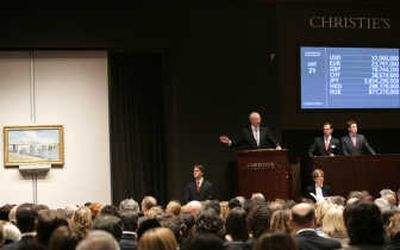Expensive art market healthy, but shows whiff of hesitation

NEW YORK – It took only about 120 seconds for a Monet to exchange hands for a small fortune recently.
The sale of “Le Pont du Chemin de Fer a Argenteuil” (“Railroad Bridge at Argenteuil”) for a total of $41,481,000 – including commission – can be seen as a bridge over troubled waters, a sign the art market is doing just fine despite the subprime mortgage crisis and whiff of recession.
After all, the price easily beat the previous $36.56 million record for a Monet, and Christie’s reaped more than $277 million during the 58-lot evening impressionist and modern art sale May 6.
But could there be cracks in that bridge? Only 44 of the lots sold and Christie’s fell short of its low $286 million pre-sale estimate total. Plus, two other works by Monet as well as works by Picasso, van Gogh, Gauguin, Renoir and Matisse failed to reach minimum bids.
There were parallels over at Sotheby’s a day later. The auction house raked in $235 million at its sale of impressionist works, easily meeting its total pre-sale estimate.
Records also were made: A cubist oil painting by Fernand Leger sold for a record $39.2 million and an Edvard Munch burst its estimate at $30.8 million.
But there also were lows: Eleven of 52 lots didn’t sell and the auction house disappointed investors with a first-quarter loss, saying revenue from auctions had declined. Its stock has lost half its value in the past year.
“The art market is alive and well. But is it booming? No,” said Howard Godel, whose Manhattan gallery specializes in 19th-century and early 20th-century American art. “I would say that there’s more caution in the air than there was six months ago for sure.”
That anyone is buying art right now might seem a minor miracle, what with stock markets struggling, credit tight, gas high, food expensive and consumer confidence tanking.
Then again, experts say any trend downward has been offset by new, hungry collectors emerging from abroad, a weak U.S. dollar making art here look cheap, hedge fund-fueled megawealth impervious to dips, and classic supply and demand.
“The art market is a funny market – it’s unlike any other,” said Betty Krulik, whose company advises, appraises and brokers American and European 19th- and 20th-century art. “If you were to compare it to a world, I’d say that you could compare it to real estate more than the stock market. There are things of great value, limited supply and unique for the most part.”
Krulik said collectors with a lot of money haven’t yet slowed down their buying, but those spending $50,000 to $300,000 have.
“As far as recession goes, not knowing how long and how deep it might be, a lot of people are just holding their money, especially people in the middle market,” Krulik said.
Marc Porter, president of Christie’s Americas, sees the market expanding upward despite turbulent swings in the financial markets.
“There has been an acknowledgment that art has been a good and stable store of value over the long term and none of the problems associated with the sort of financial stress that we now see in the financial markets are associated with works of art,” said Porter.
Art, he said, particularly the blue chip art from the auction houses, can offer investors a measure of stability not easily found in fly-by-night tech stocks or risky derivatives.
Susan Dunne, vice president of PaceWildenstein, which exhibits artists at three Manhattan galleries, said she hasn’t seen much weakening. She noted that Art Basel Miami Beach, the largest U.S. contemporary art fair with works mostly under $1 million, was crowded in December; Pace- Wildenstein rang up record sales.